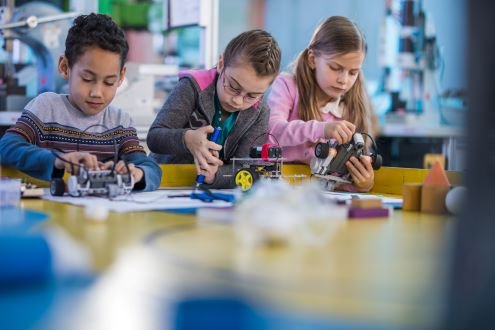The Changing Roles of Makerspaces and Libraries: Making of a National Library Maker Collective
Re-Posted from Medium with Permission by Scott Burg (@rockmaneval)
A National Maker Movement
The maker movement has emerged as a budding ground for the do-it-yourself (DIY) culture. It has become a cultural phenomenon that celebrates shared experimentation, iterative learning, and discovery through individuals and communities that build together. Makerspaces refer to any generic space that promotes this kind of active participation, skill building, knowledge acquisition and collaboration, leading to the design and creation of objects ranging from the traditional to high tech. These open spaces serve as a physical place where individuals can freely gather and share their experience and expertise.
Makerspaces are unique and original. While wildly popular across different regions and locations, the makerspace concept is still evolving, striving to be more responsive and inclusive to diverse communities. Even though everyone is allowed in a makerspace, this does not guarantee that everyone in a community will use it. Many makespaces were designed with little input from, or little consideration of community needs and interests. By collaborating with their communities, makerspaces can be more than just a sum of their activities. They can become spaces that promote and encourage agency, ingenuity, self-interpretation, and self-efficacy.
Makerspaces and Libraries
In recent years, the maker movement has also become an important phenomenon in reconceptualizing libraries of all kinds and sizes. Through a diverse array of programming, libraries are finding ways to enhance civic engagement and help people become full participants in their local communities. Today’s libraries are reinventing themselves as thriving hyperlocal community centers dedicated to learning in its many different forms, while still providing patrons with easy access to countless treasured books.
Aligning with a library’s increasing role as a central gathering place, library makerspaces have become places for community members and students to gather and learn how to create and build together, potentially providing access to resources and activities to meet the needs of under-resourced communities. Makerspaces have helped to reinvigorate the core values and roles of librarianship, drawing attention to new ways of understanding the role of libraries in the contemporary knowledge society.
Makerspaces have the potential to help libraries redefine themselves by providing new forms of exchange and engagement with and amongst the communities they serve. However for many libraries, especially those located in underserved communities that may lack adequate financial and human resources, the ability to design and manage a makerspace that meets both their internal capacity, and the expectations and needs of their respective communities (e.g., public, academic), may be difficult without proper training, guidance and support. For these spaces to be successful and sustainable, the formation of formal and informal peer networks or partnerships for sharing experiences and resources are critical.
Makers in the Library: A California Initiative
An example of one such informal partnership was Makers in the Library (2018–2020), a collaboration between the California State Library, the Bay Area Discovery Museum and Regallium Consulting. The purpose of this 3 year initiative was to provide training and support for development of makerspaces in 10 under-resourced public libraries throughout California. Sites were selected through an application process. Priority was given to sites deemed as under-resourced (serving high needs communities, operating budget per capita, staffing, etc.).
What emerged from a combination of rural, urban and suburban sites were 10 very unique models for how maker programming can thrive in communities that may often be overlooked. The process allowed staff, patrons and community partners to have a voice in designing makerspaces, which reflected the needs of their respective diverse communities. The experience also helped participating librarians think differently about their roles as professionals, in particular noting that relationships with patrons became more holistic and less transactional, in part as a result of facilitating maker activities. Participating librarians also gained knowledge and skills through peer networking.
Findings from a formal evaluation of the project, conducted by Rockman et al, found that the majority of participating librarians said their makerspaces had a positive impact on culture amongst library staff. Participants also said that the makerspaces helped to diversify their library’s services, and raised patron interest in participating and learning more about makerspace activities.
Participating library administrators concurred that maker programming had a positive impact on their respective libraries. They commented that maker programming helped attract new audiences, especially teens and younger adults. They noted that the introduction of traditional craft and more high tech activities provided their patron base access to valuable resources and materials often not available in their community’s school or home environments. Maker activities also served as catalysts for intergenerational learning and connection.
New Face of Library Makerspaces: A National Collective
The COVID-19 pandemic caused a dramatic shift in the way libraries operate and serve their communities, emphasizing the importance of continually adjusting and adapting programs and outreach. As the process of recovering from the pandemic slowly evolves, libraries will play an important role in helping communities to gather and re-engage with one another. Makerspaces can become a critical part in that re-engagement process.
Building on lessons from the Makers in the Library project, a recently awarded 2021 grant from the Institute of Museum and Library Services (IMLS) has provided funding for creation of a national Collective, entitled the New Face of Library Makerspaces, where member librarians can share resources and learnings about how library makerspaces have and will continue to shift their programming. The Collective will primarily serve libraries that have been overlooked by the maker community, including small, rural, and under-resourced libraries.
Recognizing that makerspaces are often created without a racially, ethnically, and socioeconomically diverse community in mind, the Collective will prioritize strategies for cultivating an intentionally diverse, equitable, and inclusive maker communities. Inclusion doesn’t happen naturally, it must be intentional. As such, the Collective will be focusing on methods to ensure that library makerspaces are intentional about inclusion when developing maker activities, creating maker communities, designing the actual spaces, planning events, communicating to patrons, and evaluating impact. Processes will be designed to ensure that member recruitment reflects a diversity of communities, and diversity of library professionals from all types of libraries including public, academic, school, tribal, and tool lending facilities.
To learn more about the New Face of Library Makerspace Collective, and for information on becoming a member, email Info@makersinthelibrary.org
About the Author
Scott Burg is a Qualitative Researcher and Evaluator at Rockman et al and serves as the external evaluator for The New Face of Library Makerspaces project. Read his bio. Scott originally published this article on November 18, 2021 on Medium.

